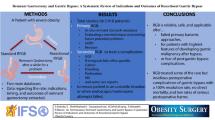Conclusion
Esophageal shortening is a real and clinically important issue for surgeons performing antireflux surgery. The ability to identify these patients preoperatively is based predominantly on experience; however, particular awareness and appropriate preparations should be made for patients demonstrating esophageal strictures and large fixed hiatal hernias. Management should include extensive mobilization of the esophagus to facilitate a tension-free reduction of the esophagogastric junction into the abdominal cavity with subsequent meticulous closure of the esophageal hiatus and anchoring of the repair within the abdomen. If tension-free reduction cannot be achieved, surgeons should be prepared to proceed with a procedure involving Collis gastroplasty or an operation such as the Hill procedure, which involves reliable anchoring within the abdominal cavity. It is currently estimated that approximately 1.5% of patients presenting for antireflux surgery will have some degree of esophageal shortening, and various estimates indicate that 20% to 70% of this population will require specialized surgery because of the inability to establish a tension-free reduction of esophagogastric junction. Based on projections that 20,000 to 40,000 antireflux procedures will be performed in the United States in the year 2000, calculations would show that between 1200 and 2500 patients will require specialized operations for esophageal shortening. Surgeons should be making every attempt to identify these patients preoperatively and have the flexibility to manage them appropriately at the time of antireflux repair.
Similar content being viewed by others
References
Henderson RD, Marryatt GV. Transabdominal total fundoplication gastroplasty to control reflux: A preliminary report. Can J Surg 1985;28:127–129.
Pearson FG, Langer B, Henderson RD. Gastroplasty and Belsey hiatus hernia repair: An operation for the management of peptic stricture with acquired short esophagus. J Thorac Cardiovasc Surg 1971;61:50–63.
Gozzetti G, Vladimiro P, Spangaro M, et al.. Pathophysiology and natural history of acquired short esophagus. Surgery 1987; 102:507–514.
Low DE, Mercer CD, James EC, Hill LD. Post Nissen syndrome. Surg Gynecol Obstet 1988;167:1–5.
Soper NJ, Dunnegan D. Anatomic fundoplication failure after laparoscopic antireflw surgery. Ann Surg 1999;229:669–677.
Kimber C, Kiely EM, Spitz L. The failure rate of surgery for gastro-oesophageal reflux. J Pediatr Surg 1998;33:64–66.
Horgan S, Pohl D, Bogetti D, et al.. Failed antireflux surgery. Arch Surg 1999;134:809–817.
Hunter JG, Smith CD, Branum, et al.. Laparoscopic fundoplication failures: Patterns of failure and response to fundoplication revision. Ann Surg 1999;230:595–604.
Skinner DB, Belsey RHR. Surgical management of esophageal reflux and hiatus hernia: Long-term results with 1030 patients. J Thorac Cardiovasc Surg 1967;53:33–54.
Hunter JG, Smith CD, Branum GD, et al.. Laparoscopic fundoplication failures: Patterns of failure and response to fundoplication revision. Ann Surg 1999;230:595–606.
Gastal OL, Hagen JA, Peters JH, et al.. Short esophagus: Analysis of predictors and clinical implications. Arch Surg 1999;134:633–638.
Pearson FG. Hiatus hernia and gastroesophageal reflux: Indications for surgery and selection of operation. J Thorac Cardiovasc Surg 1997;9:163–168.
Johnson AB, Oddsdottir M, Hunter JG. Laparoscopic Collis gastroplasty and Nissen fundoplication: A new technique for the management of esophageal foreshortening. Surg Endosc 1998;12:1055–1060.
Jobe BA, Horvath KD, Swanstrom LL. Postoperative function following laparoscopic Collis gastroplasty for shortened esophagus. Arch Surg 1998;133:867–874.
Demos MJ, Kulkarni VA, Arago A. Video-assisted transthoracic hiatal hernioplasty using stapled, uncut gastroplasty and fundoplication. Surg Rounds 1994;20:427–436.
Swanstrom LL, Marcus DR, Galloway GQ. Laparoscopic Collis gastroplasty is the treatment of choice for the shortened esophagus. Am J Surg 1996;171:477–481.
Low DE, Anderson RP, Riccardelli E, Hiu LD. Fifteen- to twenty-year results after the Hill antireflux operation. J Thorat Cardiovasc Surg 1989;98:444–450.
Mercer CD, Hill LD. Surgical management of peptic esophageal stricture. Twenty-year experience. J Thorac Cardiovasc Surg 1986;91:371–378.
Author information
Authors and Affiliations
Rights and permissions
About this article
Cite this article
Low, D.E. The short esophagus—recognition and management. J Gastrointest Surg 5, 458–461 (2001). https://doi.org/10.1016/S1091-255X(01)80082-2
Issue Date:
DOI: https://doi.org/10.1016/S1091-255X(01)80082-2




